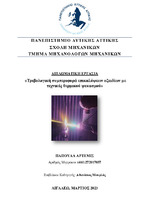| dc.contributor.advisor | Μουρλάς, Αθανάσιος | |
| dc.contributor.author | Πάπουλα, Άρτεμις | |
| dc.date.accessioned | 2023-04-07T09:57:00Z | |
| dc.date.available | 2023-04-07T09:57:00Z | |
| dc.date.issued | 2023-03-14 | |
| dc.identifier.uri | https://polynoe.lib.uniwa.gr/xmlui/handle/11400/4203 | |
| dc.identifier.uri | http://dx.doi.org/10.26265/polynoe-4042 | |
| dc.description.abstract | Η έρευνα που πραγματοποιήθηκε κατά την εκπόνηση της διπλωματικής εργασίας, αφορά στην μελέτη των τριβολογικών ιδιοτήτων, δηλαδή τη συμπεριφορά σε τριβή και φθορά, κεραμικών επικαλύψεων, που δημιουργήθηκαν με την τεχνική του θερμικού
ψεκασμού. Αρχικά δημιουργήθηκαν επικαλύψεις περιεκτικότητας 100% w/w ζιρκονίας (ZrO2) και 100% w/w αλουμίνας (Al2O3), που έχουν πληθώρα βιομηχανικών εφαρμογών, με τη μέθοδο της θερμικής ατμοσφαιρικής εναπόθεσης ψεκασμού (Atmospheric Plasma Spaying-APS) σε υποστρώματα δομικού χάλυβα, ανοξείδωτου χάλυβα, αλουμινίου και τιτανίου, στις εγκαταστάσεις της Ελληνικής Αεροπορικής Βιομηχανίας (Ε.Α.Β.). Έπειτα εξετάστηκε η τριβολογική συμπεριφορά όλων των επικαλύψεων ZrO2 και Al2O3, με τη χρήση διατάξεων ελέγχου της τριβής και της φθοράς, τύπου α) στυλίσκου-δίσκου (Pin-On-Disc) και β) τριών σωμάτων (Three Body Abrasion), βάσει των προδιαγραφών ASTM G99 και G65 αντίστοιχα. Συγκεκριμένα για τη διάταξη τύπου pin-on-disc, ως ανταγωνιστικό υλικό χρησιμοποιήθηκε σφαίρα Al2O3, η δε μελέτη πραγματοποιήθηκε για ταχύτητα ολίσθησης 20cm/sec, κάθετη φόρτιση 5Ν και για 20.000 κύκλους ολίσθησης. Από την ανωτέρω μελέτη και συμπερασματικά, οι επικαλύψεις Al2O3, εμφάνισαν υψηλότερο συντελεστή τριβής αλλά και υψηλότερη αντίσταση στη φθορά σε σύγκριση με τις επικαλύψεις ZrO2, ενώ ο κύριος μηχανισμός φθοράς για όλα τα συστήματα ήταν αυτός της λείανσης. | el |
| dc.format.extent | 128 | el |
| dc.language.iso | el | el |
| dc.publisher | Πανεπιστήμιο Δυτικής Αττικής | el |
| dc.rights | Αναφορά Δημιουργού - Μη Εμπορική Χρήση - Παρόμοια Διανομή 4.0 Διεθνές | * |
| dc.rights.uri | https://creativecommons.org/licenses/by-nc-sa/4.0/deed.el | * |
| dc.subject | Ατμοσφαιρικός ψεκασμός πλάσματος | el |
| dc.subject | Ζιρκονία | el |
| dc.subject | Αλουμίνα | el |
| dc.subject | Al2O3 | el |
| dc.subject | ZrO2 | el |
| dc.subject | Κεραμικά υλικά | el |
| dc.subject | Τραχύτητα | el |
| dc.subject | Τριβολογία | el |
| dc.subject | Φθορά | el |
| dc.title | Τριβολογική συμπεριφορά επικαλύψεων οξειδίων με τεχνικές θερμικού ψεκασμού | el |
| dc.title.alternative | Tribological behavior of thermal-sprayed oxide coatings | el |
| dc.type | Διπλωματική εργασία | el |
| dc.contributor.committee | Psyllaki, Pandora | |
| dc.contributor.committee | Panayiotatos, Yerassimos | |
| dc.contributor.faculty | Σχολή Μηχανικών | el |
| dc.contributor.department | Τμήμα Μηχανολόγων Μηχανικών | el |
| dc.description.abstracttranslated | The research carried out during the preparation of the thesis concerns the study of the tribological properties, i.e. the behaviour in abrasion and wear, of ceramic coatings created by the thermal spray technique. Initially, coatings containing 100% w/w zirconia (ZrO2) and 100% w/w alumina (Al2O3), which have a variety of industrial applications, were created by the method of
Atmospheric Plasma Spaying (Atmospheric Plasma Spaying-APS) on substrates of structural steel, stainless steel, aluminium and titanium, at the facilities of the Hellenic Aerospace Industry (HEA). Then, the tribological behaviour of all ZrO2 and Al2O3 coatings was investigated using 2 types abrasion control devices, a) Pin-On-Disc and b) Three Body Abrasion, based on ASTM G99 and G65 specifications respectively. Specifically for the pin-on-disc type assembly, Al2O3 sphere was used as the competing material and the study was carried out for a sliding speed of 20cm/sec, a vertical load of 5N and 20 000 sliding cycles. From the above study and in conclusion, Al2O3 coatings, showed higher coefficient of friction and also higher wear resistance compared to ZrO2 coatings, while the main wear mechanism for all systems was that of abrasion. | el |


